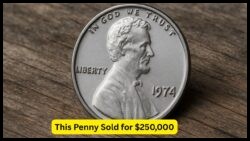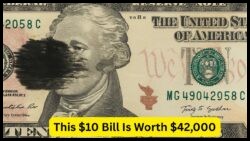Rare 1971 Eisenhower Dollar – The world of coin collecting is full of surprises, but every once in a while, a truly rare and unusual piece makes headlines. One such instance is the recent sale of a 1971 Eisenhower Dollar struck on a nickel planchet, a mint error so rare that it fetched $9,500 at auction. This sale has stirred up excitement among numismatists and investors alike, as error coins like these are not only valuable but offer a fascinating glimpse into the U.S. Mint’s production process. This article dives into what makes this coin so special, how such minting errors occur, and why collectors are willing to pay a premium for them.
What Is the Eisenhower Dollar?
Introduced in 1971, the Eisenhower Dollar was the first U.S. dollar coin issued after the Peace Dollar series ended in 1935. It commemorated President Dwight D. Eisenhower and also honored the Apollo 11 Moon landing.
Key facts about the Eisenhower Dollar:
- First minted: 1971
- Composition: Copper-nickel clad, except for some silver collector editions
- Weight: 22.68 grams
- Diameter: 38.1 mm
- Designer: Frank Gasparro
Though millions were minted, only specific variations, such as proof coins, silver issues, or error coins, attract high collector value.
How Was This Error Coin Created?
Coins struck on the wrong planchet—like a nickel planchet instead of the proper dollar planchet—are rare but not unheard of. This particular Eisenhower Dollar was struck on a nickel planchet, typically used for Jefferson nickels.
How does this happen?
- A nickel-sized blank mistakenly enters the press set for Eisenhower Dollars.
- The smaller nickel planchet doesn’t fill the entire die area, creating a smaller, off-sized coin with incomplete design.
- Since the machinery is meant for a larger coin, parts of the image may be missing, especially around the edges.
Why Did It Sell for $9,500?
The value of error coins is based on rarity, demand, visual appeal, and historical significance. In this case, several factors pushed the price to nearly $10,000.
Factors influencing the price:
| Factor | Details |
|---|---|
| Rarity | Very few Eisenhower dollars struck on wrong planchets exist |
| Error visibility | Clearly identifiable as a wrong-planchet strike |
| Condition | Likely graded high by a reputable agency (e.g., PCGS or NGC) |
| Collector interest | Error coins have a devoted niche of collectors |
| Auction house promotion | Marketed well, increasing competition during bidding |
Physical Differences from a Normal Eisenhower Dollar
One key aspect collectors look for is how the error coin compares visually and physically with standard issues.
Comparison Table:
| Feature | Standard 1971 Ike Dollar | Error Coin on Nickel Planchet |
|---|---|---|
| Weight | 22.68 grams | ~5 grams (approximate for a nickel) |
| Diameter | 38.1 mm | 21.2 mm (typical for nickels) |
| Metal Composition | Cu-Ni clad | Cu-Ni but in different proportion |
| Design Completeness | Full detail | Partial, cutoff edges |
| Edge | Reeded | Plain or partially reeded |
This physical misfit between die and planchet makes these coins instantly eye-catching and unmistakably unique.
Why Collectors Love Mint Errors
Mint error coins offer collectors something beyond the ordinary—pieces of history that reveal flaws in a process meant to be precise. These coins not only have aesthetic oddity but also tell a story.
Types of mint errors often collected:
- Wrong planchet errors
- Double strikes
- Off-center strikes
- Die cap errors
- Clipped planchets
In the case of this 1971 Eisenhower Dollar, its rarity combined with a popular series and clear error made it especially desirable.
Market Trends for Mint Error Coins
In recent years, error coin values have surged, especially for unique and early errors. Coins from the 1960s–1970s hold particular charm due to transitional errors, wrong planchet strikes, and the end of silver in general circulation.
Sample of other high-value mint error coins:
| Coin Type | Error Description | Auction Price |
|---|---|---|
| 1943 Bronze Lincoln Cent | Wrong planchet during steel year | $204,000 |
| 2000 Sacagawea on Quarter Planchet | Bimetallic transitional error | $7,637 |
| 1971 Ike Dollar on Nickel | Wrong planchet (this case) | $9,500 |
| 1965 Quarter on Silver Planchet | Wrong metal during transition to clad | $7,000+ |
The sale of the 1971 Eisenhower Dollar struck on a nickel planchet for $9,500 is a reminder of how captivating error coins can be. Whether you’re a seasoned numismatist or just beginning to explore the world of coin collecting, keeping an eye out for mint errors could prove both thrilling and profitable.
This coin is more than just a mistake—it’s a rare piece of history that speaks to the complexities of minting and the passions of collectors worldwide.
FAQs
Q1. What is a planchet in coin terminology?
A planchet is a blank metal disk on which a coin design is stamped.
Q2. How can I identify if I have an Eisenhower Dollar error coin?
Look for signs like wrong size, unusual weight, off-center strike, or missing details. Getting it graded helps.
Q3. Are all 1971 Eisenhower Dollars valuable?
No, regular 1971 Ike Dollars are common. Only rare variants or error coins have high value.
Q4. Can I sell a mint error coin without certification?
Yes, but grading by agencies like PCGS or NGC often boosts buyer trust and value.
Q5. Where can I sell a rare error coin?
Reputable auction houses, coin dealers, or online platforms like Heritage Auctions or eBay.






